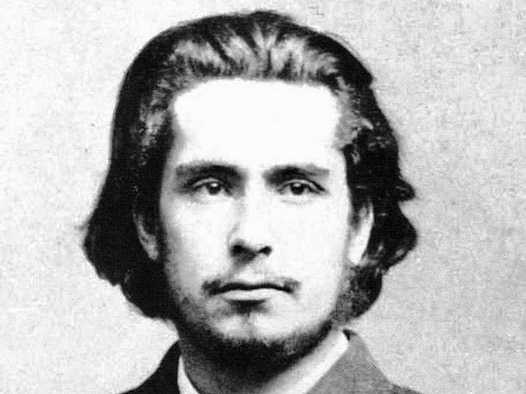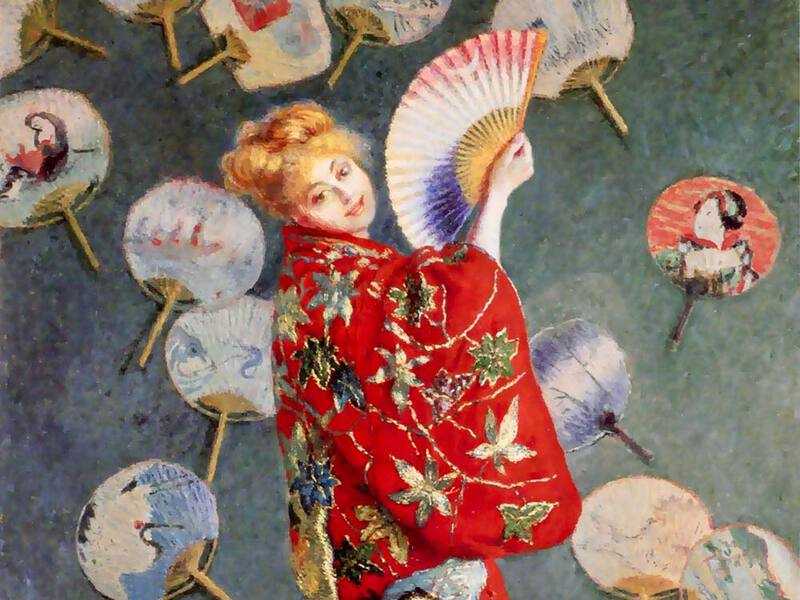1. The Painting
Monet painted ‘Impression, Sunrise’ from the window of the Hôtel de l’Amirauté in Le Havre on 13 November 1872.
The window overlooked the port of Le Havre, on the English Channel in northern France, giving Monet a perfect view to paint the harbour at sunrise. Monet probably painted the picture in one sitting.
The scene
The eye is immediately drawn to the rising sun and the reflection it casts in the water. Most viewers then notice the central rowing boat and a secondary rowing boat in the fore- and mid-ground: they seem to be travelling slowly, as if the oarsmen are waking up with the sun.
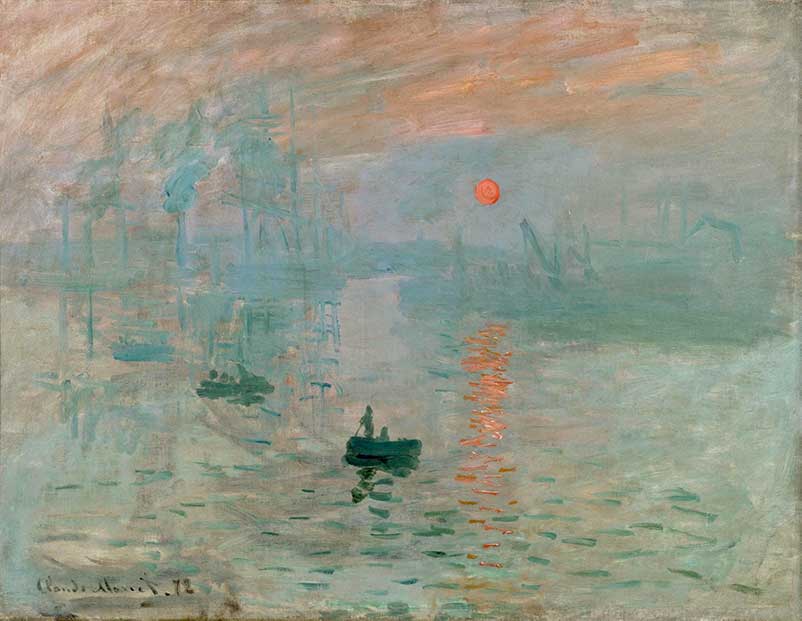
Closer inspection reveals:
- A third rowing boat (to the top left of the second) (RED)
- The masts of anchored clipper ships (behind the second rowing boat), one of which can also be seen reflected in the water (YELLOW).
- Factory chimneys puffing out smoke (next to the clippers) (GREEN).
- Cranes and derricks on the dock, ready to unload ships (BLUE).
- The impression that the Harbour is shrouded in a light mist.
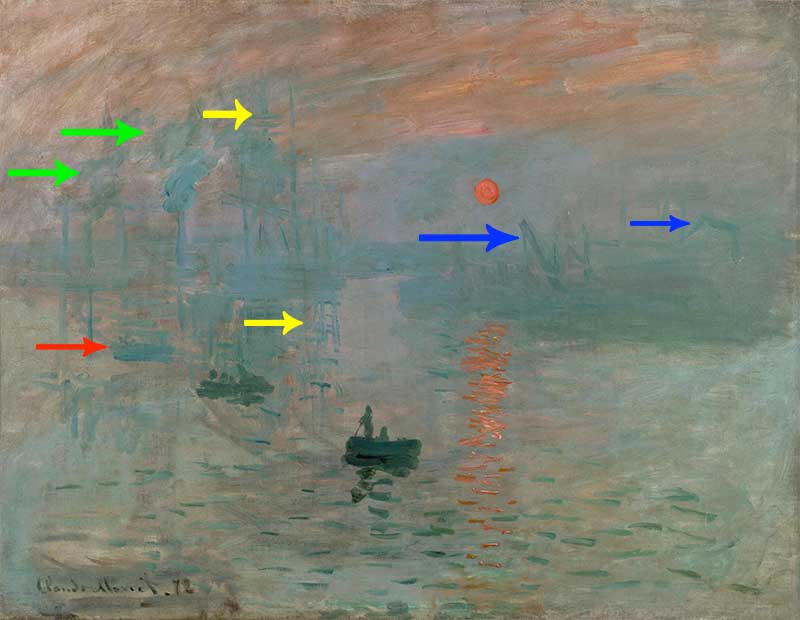
Impressionist traits
Unsurprisingly, Impression: Sunrise displays a number of key impressionist traits.
First, and most importantly, Monet was not trying to produce a photographic representation of the port. Instead, he sought to capture his impression of the scene. This can be seen in a number of ways:
- The painting was almost certainly produced in one sitting, as Monet raced to capture the rising sun. See, for instance, the very broad brush strokes at the top of the canvas.
- Monet did not paint everything that he saw. For example, he excluded some houses on the left side of the scene that he thought were too ugly!
Secondly, this is a modern scene of a recently industrialised port. The painting of modern life was key to the impressionists, who rejected the historical, allegorical and religious scenes favoured by the conservative art establishment.
Thirdly, the painting uses colour in a bold fashion - the eye is immediately drawn to the circular sun. And, like most of the impressionists, Monet makes sparing use of black (to emphasise the central rowing boat).
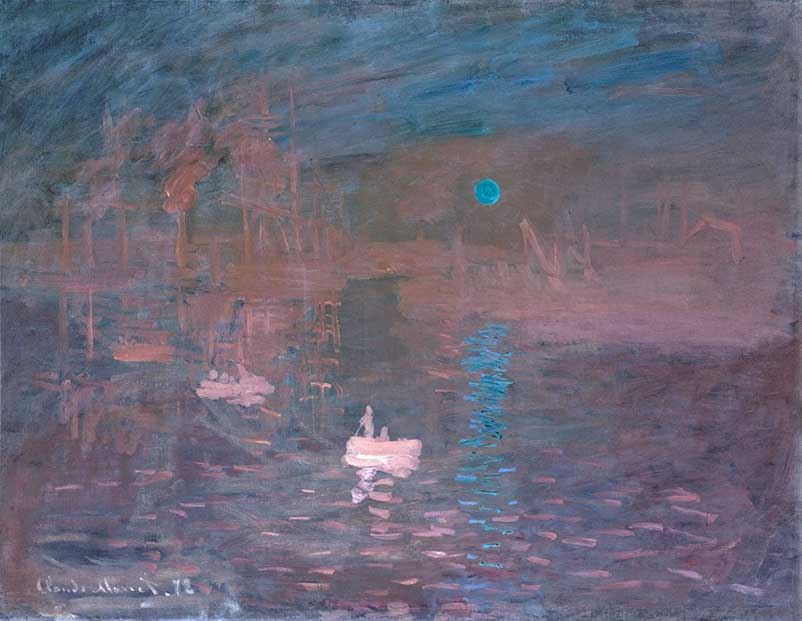
Other paintings of Le Havre
Monet in fact produced a number of other paintings of Le Havre, including five more canvasses on the same trip in 1873.
The below painting, Sunrise (Marine), bears similarities to Impression: Sunrise. Though the sun is less prominent, the same shades of grey are used, and Monet paints another rowing boat and more ships' masts in the background.

2. Inspiration for Impression: Sunrise
Impression: Sunrise was influenced by the English landscapist JMW Turner and by Japanese prints.
JMW Turner's inspiration
Much of the inspiration for the work was drawn from Joseph Mallord William Turner’s ‘The Scarlet Sunset’ from 1839-40. Monet would have seen the painting whilst in exile in London in 1870-71 fleeing from the Franco Prussian War.
Like ‘Impression, Sunrise’, Turner’s painting features a limited range of colours and strong colour contrasts to create a hazy, striking painting.
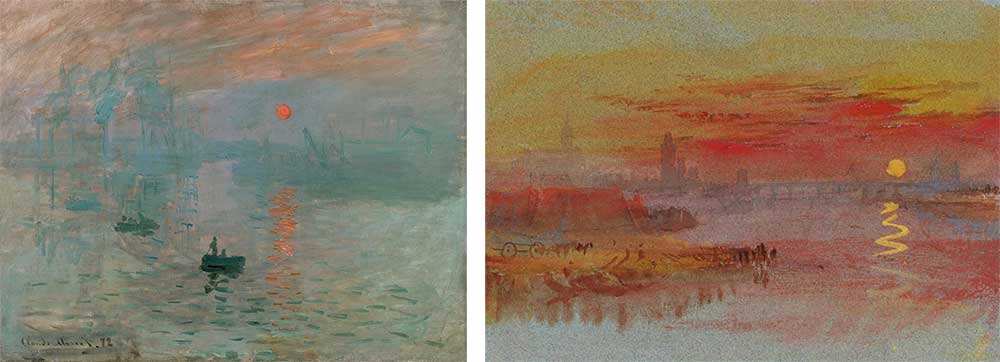
Turner often painted on blue paper during this period of his career and it is this backing that produced the blue tones seen in The Scarlet Sunset. Like the Impressionists, he also used extremely opaque pigments to create the colour effects in his later works.
Monet retrospectively (and unconvincingly) denied any influence from Turner on his work:
“Once I liked Turner very much, but now I like him less - he did not lay out his colour carefully enough, and he used too much of it. I have studied him well.”
(This quote was attributed to Monet by the French art dealer René Gimpel in 1918.)
Japonisme
For this painting, Monet also drew inspiration from ‘Japonisme’, which had been an important cultural influence in France and Europe since the late 1850s.
The arrival of Japanese prints and other decorative objects in France had led many artists to begin incorporating Japanese themes and techniques into their artworks.
It is thought that Monet began collecting Japanese woodblock prints as early as 1871 during a trip to Holland. By the time of his death, he had an extensive collection of works by Utamaro, Hokusai, and Hiroshige.
The influence of Japanese prints on Impression: Sunrise is evident from certain techniques used in the painting such as the depiction of moving water, the position of the boats and the blending of the land and the sky.
Art historians have linked Monet’s painting to several Japanese prints with similar details. These include ‘Meisho Edo Hyakkei-Shiba Ura no Fukei’ (View of Shiba Coast from One Hundred Famous Views of Edo) a 1856 print by Hiroshige, which has parallels in the angle of the three boats shown in the foreground of the work.

Meanwhile, a print by Hokusai from 1833 titled ‘Moonlight on the Yodo River’ from his ‘Snow, Moon and Flowers’ series is thought to have been a source of inspiration for Monet, especially in the method of blending the sky and the land so that it is difficult to tell where one ends and the other begins. The moon in Hokusai’s print is also very similar to Monet’s sun.
Hiroshige’s 1858 work ‘Mouth of the Aji River in Settsu Province, from the series Wrestling Matches between Mountains and Seas’ also closely resembles the composition of Monet’s Impression, Sunrise.
Monet’s quick, short brushstrokes are reminiscent of Japanese prints which tended to favour hard vertical and diagonal lines. He deliberately painted with a lack of detail, especially when creating the backgrounds for his works and this could also have been borrowed from Japanese prints, such as the works of Utamaro.
Monet's own contribution
Despite these varied influences, Monet also made something that was entirely his own. As the scholar John House describes:
“Japanese art helped him to see the pictorial possibilities of such forms and suggested ways of framing them on the canvas, but the final structure of each picture is the result of his direct confrontation with the motif.”
Monet’s inclusion of industrial elements in ‘Impression, Sunrise’ singled him out as a painter of modern life. He chose to show the landscape as it had been shaped by recent events and construction, rather than erasing these structures from the scene.
In this way, Monet’s painting does not reference a lost past: it is rooted firmly in the present.
3. Value of Impression: Sunrise
We estimate that Impression: Sunrise is worth US$250-350 million
The first two sales
Impression: Sunrise was bought by one of Monet's most dependable patron's, Ernest Hoschede, after the first impressionist exhibition in 1874 for the respectable sum of 800 francs. Hoschede was a department store owner and bon viveur.
Sadly, Hoschede fell on hard times and was bankrupted within a few years. His assets, including Impression: Sunrise, were seized and sold at auction in 1877. This time, the painting only fetched 210 francs.
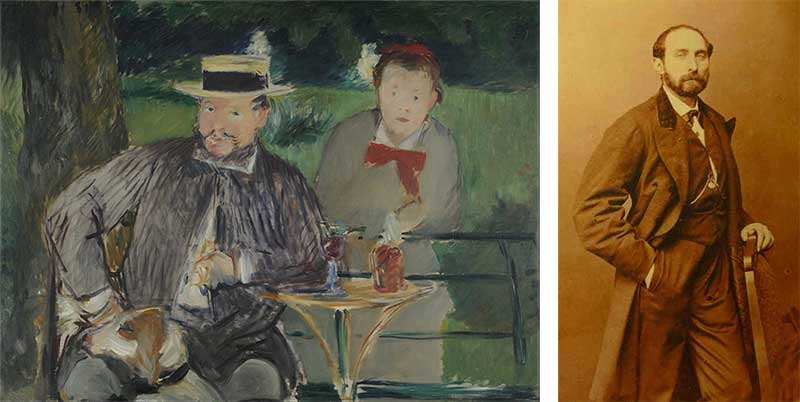
The purchaser was Dr Georges de Bellio. He retained the painting until his death in 1894, when it was inherited by Dr de Bellio's daughter (Victorine Donop de Monchy). She left it to the Musee Marmottan Monet in Paris on her death in 1940.
The 1985 Theft
As we explain on our top 10 impressionism thefts page, Impression: Sunrise was stolen at gunpoint from the Musee Marmottan Monet in 1985 and not recovered for five years.
When the painting was stolen, Impression: Sunrise along with eight other paintings were given an aggregate valuation of US$12.5 million. (One reason for this low valuation was that Impression: Sunrise was too well known to be sold on the open market.)
When Impression: Sunrise was recovered, Monsieur d'Hauterives (the Director of the Marmottan) said:
"This painting marks a turning point in the history of modern art."
Current Market Price
Since then the price for Impressionist paintings, and especially works by Monet, has increased significantly. For example:
- In May 2019, one painting from Monet's ‘Haystacks’ series from 1890 sold for a staggering $110.7 million at a Sotheby’s auction, pushing the price of the painting to 44 times the amount the seller had paid.
- In May 2018, a version of Monet's water lilies (Nympheas en Fleur) was sold by Christie's New York for $84,687,500.
- In November 2016, another version of Haystacks sold for $81.4 million (again by Christie's New York).
The red-hot impressionist market is further illustrated by the sale of Cezanne's Card Players for a world-record price of $259 million in February 2002. Further information is available on our most expensive paintings page.
Given the market trends summarised above, and the fame and importance of Impression: Sunrise, we consider that it would sell for c. US$250-350 million if it were ever to come onto the market.
4. The First Impressionist Exhibition
‘Impression, Sunrise’ was displayed to the public at the First Impressionist Exhibition in the spring of 1874.
In contrast with the official Paris Salon, organised by a panel of conservative judges, the first impressionist exhibition allowed the impressionists to exhibit the kind of work they wanted to create.
At this time, the group was called the Anonymous Society of Painters, Sculptures, Printmakers etc. and the key members included Monet, Camille Pissarro, Alfred Sisley, Auguste Renoir, Berthe Morisot and Edgar Degas.
Organisation
The exhibition was held at the studio of a photographer called Nadar on the Boulevard des Capucines.
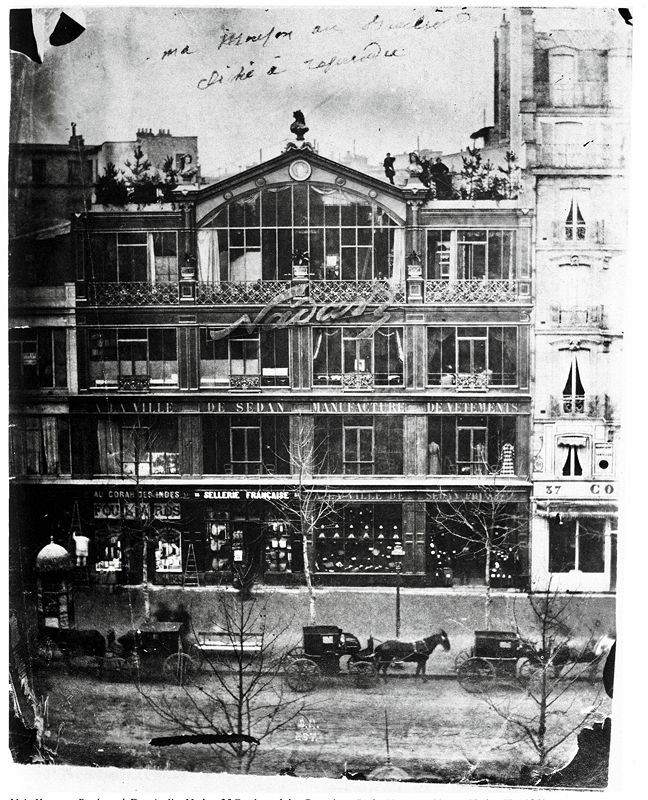
The group was organised democratically and a number of protocols were put in place to make sure that the exhibition would be fair.
- Instead of hanging the paintings on multiple levels, for instance, with younger and lesser known artists at the very top, the Impressionists agreed to hang their work in two rows.
- The smaller pictures went below and the larger works went on top.
Here's a photo of the catalogue:
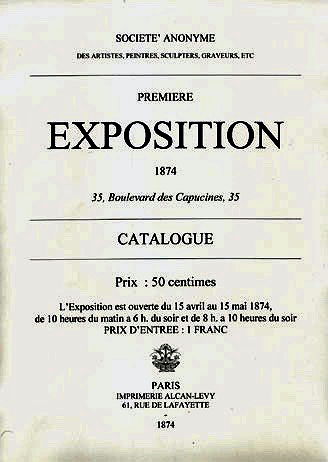
Naming of Impression: Sunrise
No great thought went into the naming of Claude Monet's Impression: Sunrise.
Renoir's brother Edmond was in charge of producing the catalogue for the first exhibition. Monet explained what happened next as follows:
"They asked me for a title for the catalogue. Because it couldn't really be taken for a view of Le Havre, I said: 'Put Impression.'"
Edmond added the 'Sunrise' - and the rest is history. The French name of the work is 'Impression: Soleil Levant'.
Negative reception
This refreshing, daring alternative to the Salon drew a lot of attention from the press. It was even said in some quarters that the Salon had become too restrictive and that its 1872 edition had failed to reflect recent history (and in particular the 1870-1871 Franco-Prussian war).
But overall the critics were harsh. Take the words of Jules Castagnary:
“Coming after the war and the terrible events of the past year, the show should have had an original and gripping make-up. Instead, it is absolutely devoid of character. […] You walk around there not knowing what country you're in or what year it is. It doesn't have the soul or life of France.”
Many of the artworks were met with derision. For example, the art critic Louis Leroy described the paintings on display as
“hostile to good artistic manner, to devotion to form, and respect for the masters.”
Unfortunately, Leroy was not the only critic to ridicule the first impressionist exhibition. The critic for La Patrie newspaper for instance described how:
“Seeing the lot, you burst out laughing but with the last ones you finally get angry and you're sorry you did not give the franc you paid to get in to some beggar.”
Leroy's Review
Leroy's review is arguably the most important ever produced in the history of art.
First, it was entitled
"Exhibition of the Impressionists at the Boulevard des Capucines."
Though the term 'impressionism' had been used before, it was only after Leroy's article that it began to catch on. Leroy of course intended it as a term of insult. But by the third impressionist exhibition, the impressionist group had adopted it. And it stuck.
Secondly, Leroy's article was remarkably scathing of Impression: Sunrise. The article took the form of a spoof discussion between a professor of art (called Vincent) and his student, which takes place whilst walking around the first exhibition.
In relation to Impression: Sunrise, Leroy said the following:
"'What does this one represent?' asks Vincent. 'What does the catalogue say?'
'Impression: Sunrise.'
'Impression! Of course. There must be an impression somewhere in it. What freedom ... what flexibility of style! Wallpaper in its early stages is more finished than that.'"
Thirdly, it was not just Monet who was criticised. Pissarro's Hoarfrost came in for a bashing too. Here, Leroy wrote:
"'Those? Ploughed furrows? That is hoar-frost? But they're nothing but palette scrapings, put down in parallel lines on a bit of dirty canvass. There's no head or tail to it, no top or bottom, front or back.'
'That may be so; but it is an impression, nonetheless.'
'Well, it's a weird impression'"
Leroy's criticisms of Pissarro were as unfair as his criticisms of Monet. Here is the beautiful Pissarro canvass that he was attacking:
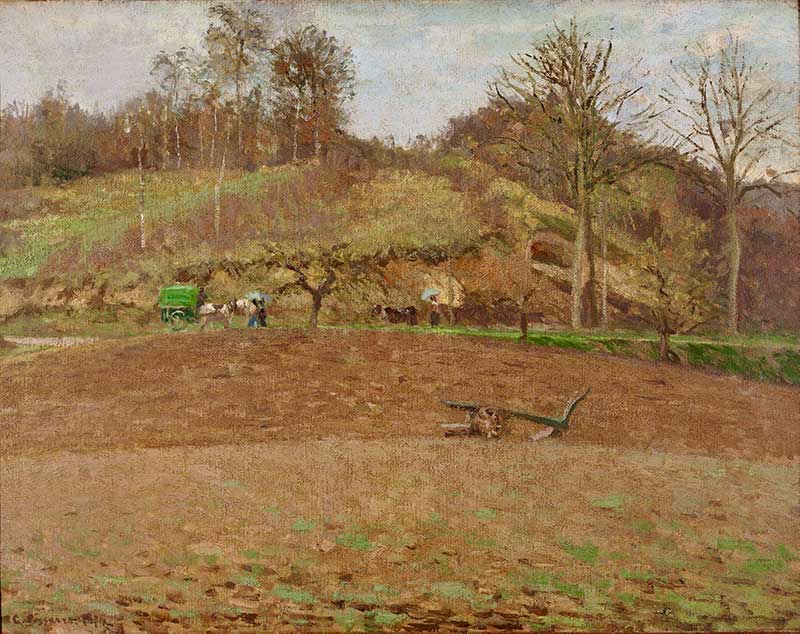
Positive reviews
On the other hand, not all of the reviews of the exhibition were as insulting.
Emile d’Hervilly wrote about the show for Le Rappel, describing Monet’s work as possessing “infinite grace and spirit.” He also praised the show as a whole, saying that the works were “fresh” and “gripping” and that their
“generous exaggerations are even charming and consoling when one thinks of the nauseating banalities of the academic routine.”
Armand Silvestre also offered his support describing Monet as “the cleverest and the most daring” of the artists featured in the exhibition. He believed,
“You need special eyes in order to be sensitive to the subtlety of their tonal relations, which constitute their honor and merit”.
At the same time, however, he was unsure of their pursuit of the ‘impression' and its suggestion that everything in the world is beautiful enough to be worth painting.
In all the reviews of the exhibition, ‘Impression, Sunrise’ was only referenced five times. Overall it failed to gain the attention that other paintings did and was far behind the most talked about of Monet’s works, which included Boulevard des Capucines (below). Ernest Chesnau, for instance, simply described that he stopped in front of the painting. He does not offer any further description or opinion on the piece!
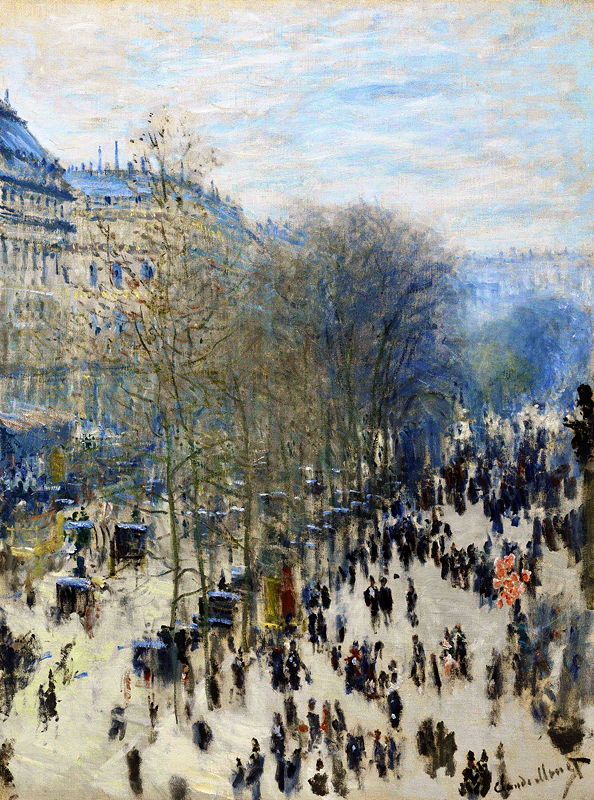
To learn more, why not check out our page on the first impressionist exhibition?
5. Context: Monet in the 1870s
At the time when ‘Impression, Sunrise’ was painted, Monet had recently returned to France from Holland.
London to Holland to Le Havre
He had made the journey to Holland from London where he had sheltered during the Franco Prussian War. Writing to Pissarro in June 1871, he described how,
“We’ve been completely without news of Paris since we left London, it’s impossible to get a French newspaper here.”
The sights that greeted him on his return must have been shocking. Argenteuil (the village on the outskirts of Paris where Monet lived) had been occupied by the Prussian army and the railroad and highway bridges had been completely destroyed.
Industrialisation
During this period, Monet chose to paint images of industrialisation in France. They included images of bridge-building, trains and other technological advancements. Whilst they gave Monet ample modern subjects to paint, they also proved to be fairly lucrative for the artist.
In 1872, for instance, he successfully sold ‘The Highway Bridge’, ‘The Train’ and ‘The Path Through The Vineyards’, as well as a number of other works.
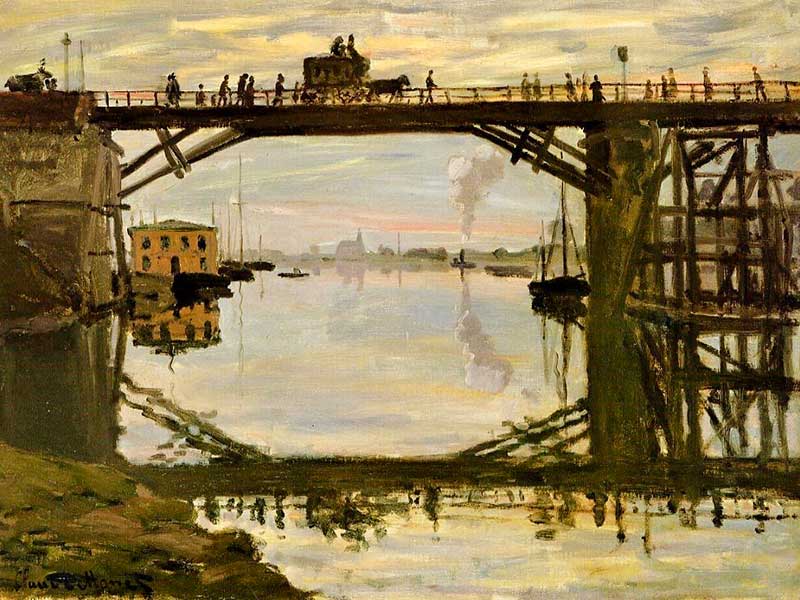
In total, Monet earned 12,000 francs from the sale of his paintings in 1872, a good income considering doctors or lawyers in Paris would earn around 9,000-10,000 francs at this time. In this context, ‘Impression, Sunrise’ would have been painted as much as a commercial decision as an artistic one.
Le Havre
Le Havre was one of the busiest ports in France in the early 1870s and would have been a popular subject for newly wealthy industrialists and the growing middle class who had their roots in commerce.
‘Impression, Sunrise’ signified the strength and beauty of France as it recovered from war. It formed a patriotic statement that fitted with public demand at the time.
In the words of Paul Tucker
“The sense of renewal or of becoming is felt in the picture as a whole: in the sun's clear spherical penetration of the mist, in its dappled reflections which pull it forward, in the billowing smokestacks on the left and that side's contrast with the right”.
As well as painting a sunrise, a typical subject for landscape painters, Monet also chose to capture the hope and energy surging through France during the 1870s thanks to its determined post-war efforts. The result is that ‘Impression, Sunrise’ forms:
“[a] progressive, consummately beautiful scene, where man clearly has his place”.
6. Changing Perspectives on Impression: Sunrise
Over the years, ‘Impression, Sunrise’ was given numerous different names by writers and archivists.
In 1878, for instance, the painting was put up for auction with the name “Impression, Sunset”.
The following year, it was listed with the name “Fog Effect”. Another writer misplaced the location of the painting, describing in 1927 that the work had been painted on the banks of the River Seine.
Speaking later, in 1897, Monet described his decision for the title of his painting:
“I had something I painted from my window in Le Havre: the sun in the mist and in the foreground some masts sticking up. They wanted to know its title for the catalogue because it couldn’t really pass for a view of Le Havre. I replied, ‘Use Impression.’”
When was it painted?
As well as the name, there has been much debate and confusion surrounding the year in which the painting was produced. Monet’s original signature has the number “72” next to it, but many subsequent dealers and writers attributed the work to different years.
In 2014, researchers at the Musée Marmottan Monet in Paris carried out a forensic analysis of the painting in order to determine the exact date on which the painting was created.
Employing an astrophysicist named Donald W. Olson, the museum was able to piece together the weather conditions on the day that Monet painted the piece, using meteorology records from the port.
Subtle clues such as the haze in the painting, which would have corresponded with mist or fog, and the waft of smoke plumes from east to west, which indicated the wind direction, gave the curators the information they needed to date the painting to November 13, 1872.
Theft ...
Though the work was largely ignored and undervalued when it first went on display, it has gathered much more attention in subsequent years.
On October 27, 1985, a group of five armed men entered the Musée Marmottan Monet and forced everyone in the exhibition space onto the floor. The thieves included Shuinichi Fujikuma, Youssef Khimoun and Philippe Jamin, who had met in a French prison in 1978.
Among the works stolen during the heist was ‘Impression, Sunrise’ and several other famous Impressionist works by Monet, Morisot and Renoir.
... and recovery
The paintings were later recovered in Porto Vecchio, Corsica on December 5, 1991.
Incredibly, the work had sustained no damage during the heist or its transportation:
"except that of being shut up in a cubbyhole for five years,”
in the words of Arnaud d’Hauterives, the curator at the Marmottan Museum.
When the painting was returned to Paris, curators carefully removed the discoloured varnish that had been applied to the painting and they restored the colours of the oil paints. It now hangs in the basement of the Musée Marmottan Monet, where it has become one of the most popular exhibits on display.
In September 2022, a major Indian newspaper carried a story on Impression: Sunrise, showing its worldwide appeal.
7. Where can I see Impression: Sunrise?
Impression: Sunrise is the jewel in the crown of Paris' Musee Marmottan Monet.
The Marmottan Monet displays the collection of Jules and Paul Marmottan in an impressive mansion in Passy in the 16th Arrondissement in east Paris.
The museum holds a number of important impressionist works by the likes of Morisot, Renoir, Degas and Manet. But the real fun starts when you reach the basement, with Impression: Sunrise and 13 huge water lily canvasses.
Top Tip
Don't overlook the Marmottan Monet when you visit Paris. Aside from its stunning collection, it is far less busy than the Musee d'Orsay and the Musee de l'Orangerie.
Last time I went, I spent five minutes standing in front of Impression: Sunrise with nobody else around!
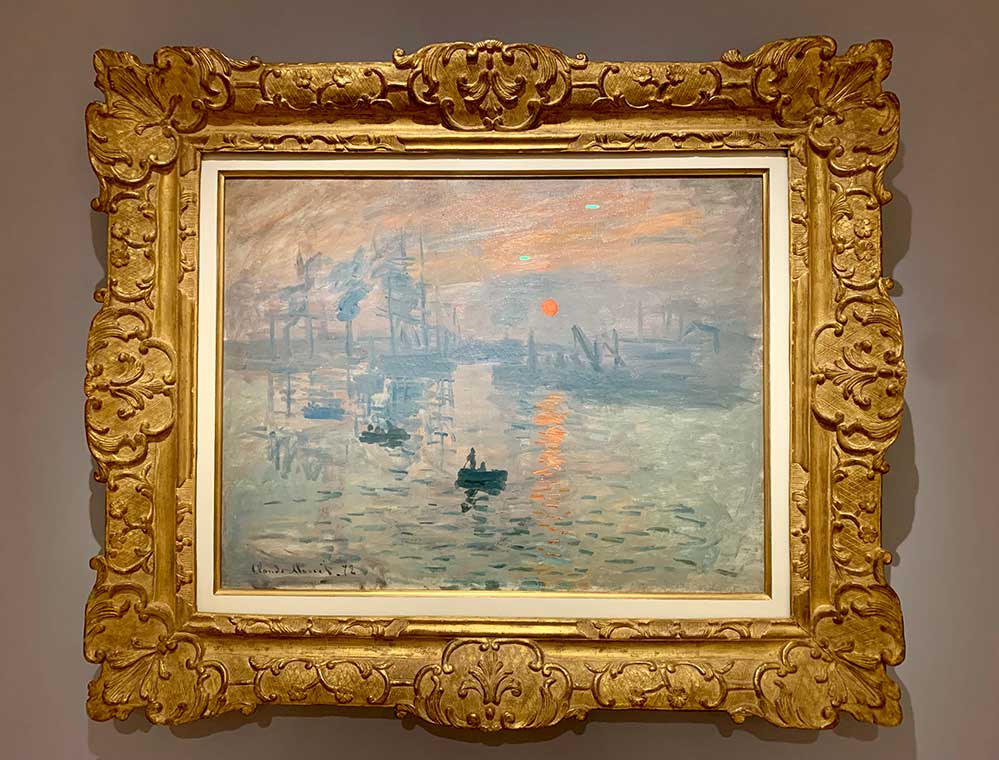

8. Learn more
Learn more about Claude Monet, his work, and the impressionist movement on this website.
We recommend:
- Our Claude Monet biography page.
- Our Impressionism: Timeline page.
- Our Top 10 Impressionist Paintings page (Impression: Sunrise unsurprisingly makes the top ten).
Further reading
Strange as it may seem, there is no stand-out biography on Claude Monet that remains in print. For a coffee-table sized hardcopy biography, we do however recommend Daniel Wildenstein's Monet: the Triumph of Impressionism.
We also recommend, for a fabulous paperback charting the second half of Monet's life, Ross King's Mad Enchantment. Focussing on Giverny and Manet's obsession with water lilies, this book gives fabulous insight into Monet's character and relationships with people like French PM George Clemenceau.
The best single book on impressionism is Sue Roe's The Private Lives of the Impressionists.
Learn more on our Books, Videos and Gifts page.



